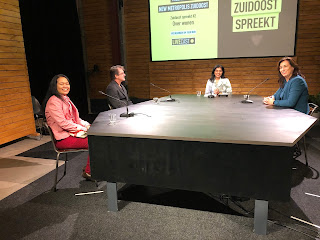Reviving the Deli Planters!
Industrial Heritage of Indonesia Series #1
Reviving the Deli Planters!
Indonesian Plantation Museum (Museum Perkebunan Indonesia-Musperin)
An exemplary public-private
partnership in heritage conservation of Indonesia. Two plantation museums in 5
years period is a relatively huge achievement for the industrial heritage of
Indonesia. This is only possible with the ideal combination of financial support of
the plantation state company, in this case, PTPN II, museum professional executive the board led by Sri Hartini, and active involvement of community organizations
like Sumatra Heritage Trust.
Soedjai Kartasasmita, the leading figure of plantation
industry of Indonesia has taken an initiative to establish a museum to convey
history of plantation of the country to the young generation. He was and is
still supported by the energetic museum director, Sri Hartini, to fulfill the
dream.
The museum was formally opened on 10 December 2016 at
a complex of historical buildings in Medan, North Sumatra (built-in 1917). The
buildings belong to the AVROS, the Dutch abbreviation for the Association of
Rubber Planters in the East Coast of Sumatra. This Association was
established by plantation investors such as Horisson and Crosfield and Goodyear
Rubber Company. In the end, this was not only an association for the rubber
planters, but also oil palm, tobacco, and other commodities planters.
In front of the building, the visitors will see the
locomotive of Ducro & Brauns made in the Netherlands that was in operation
until 1996, a lorry to transport oil palm made in Germany that was in operation
until 2015, and an airplane to spray pesticide made in America that was in
operation until 2007.
In 2021, Musperin is busy preparing the second museum
at Badan Kerja Sama Perusahaan Perkebunan
Sumatera (BKS-PPS) Building, also in Medan. This institution is the
continuation of AVROS. Now, this association consists of 162 plantation
companies in Sumatra from all sorts of backgrounds (domestic, international,
government, private sector).
The BKS-PPS Building has a strategic location at the
corner of the business and historical district Kesawan. The green dome with its
clock at the highest point is in the renovation process so the general public would be
able to climb to this point and the floor will function as a working space as
well. Those who will enjoy the busy city center could sit at a café at the
same level as the museum display.
A special element from this second museum, on the
third floor there is a room that used to be called the Dactyloscopy Bureau (dactyloscopy
is a method of using fingerprints for identification). Here hundred thousand
fingerprints of plantation workers from Java and China are well kept. These fingerprints are witnesses of the heyday of the plantation industry not only on the East Coast of Sumatra but also in the Dutch
Indies and Indonesia. It is worth consideration to registering these important
fingerprints in the list of Memory of the World. For that purpose, Musperin has
a digitalization program to record all the fingerprints.
Historical Snapshots Plantation Industry in Indonesia
Coffee came to the Dutch Indies in 1646 and in 1712 the
first export to Amsterdam. In 1900 the new coffee variety Robusta from
Congo was introduced and now the most common commodity from Indonesia.
Oil Palm was in the early 19th century only planted
along with street shadow plants. In 1902 an oil palm processing machine was
discovered in East Sumatra. In 1911 an oil palm plantation was opened by the
French-Belgium company SOCFIN (Société
Financiére des Caoutchoucs). In 1918 England opened an oil palm plantation
in Malaya with Deli Dura seeds from Buitenzorg
(the current Bogor).
Tea was produced in Malabar and Tanara, West Java, by
Karel Albert Rudolf Bosscha, in 1686. The first tea factory outside Java was in
Simangulun, North Sumatra, opened in 1910. Now the famous tea from Sumatra is
Kayu Aro Tea from Jambi.
Cacao was already planted in Indonesia since 1560 but widely
exploited in Central Java around 1880.
Tobacco was exploited in Sumatra by Jacobus Nienhuys and in
1869 Deli Maatschappij (Deli
Enterprise) was established following the economic booming of tobacco exports from
the East Coast of Sumatra. After the Independence, Soekarno represented
Indonesia and Conrad Adenhaver represented Germany, opened the tobacco auction
center in Bremen, Germany, called Tabak
Bõrse. Deli Sumatra Tobacco was famous in the world due to this place.
Other types of tobacco were from Jember, East Java,
called Besuki Na Oogst (BNO), and from
Klaten. Both are called Javanese Tobacco, and from Deli called Sumatran Tobacco.
(Resource: BKS-PPS and Musperin, pictures: Hasti Tarekat, Harditaher Musperin)












Comments